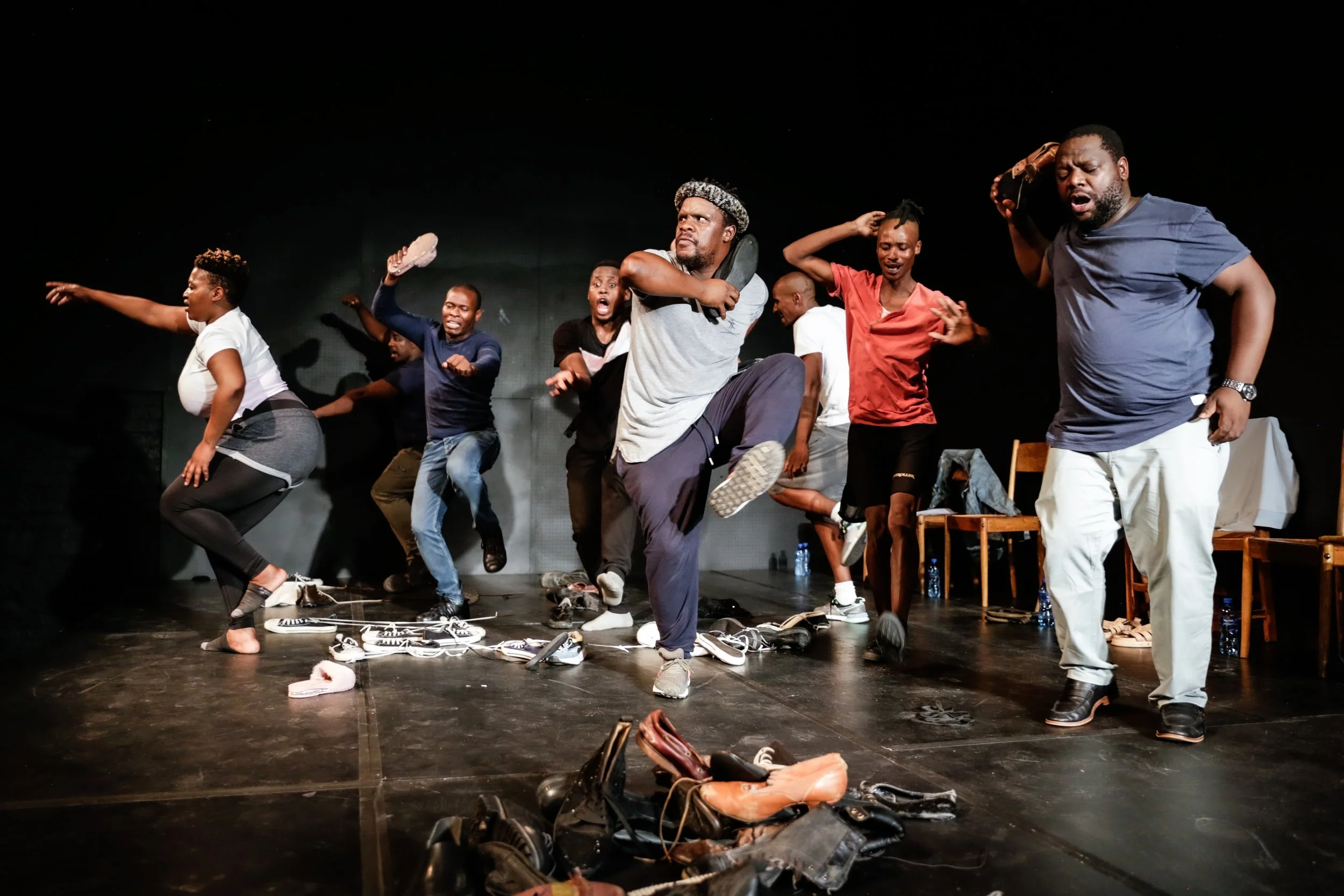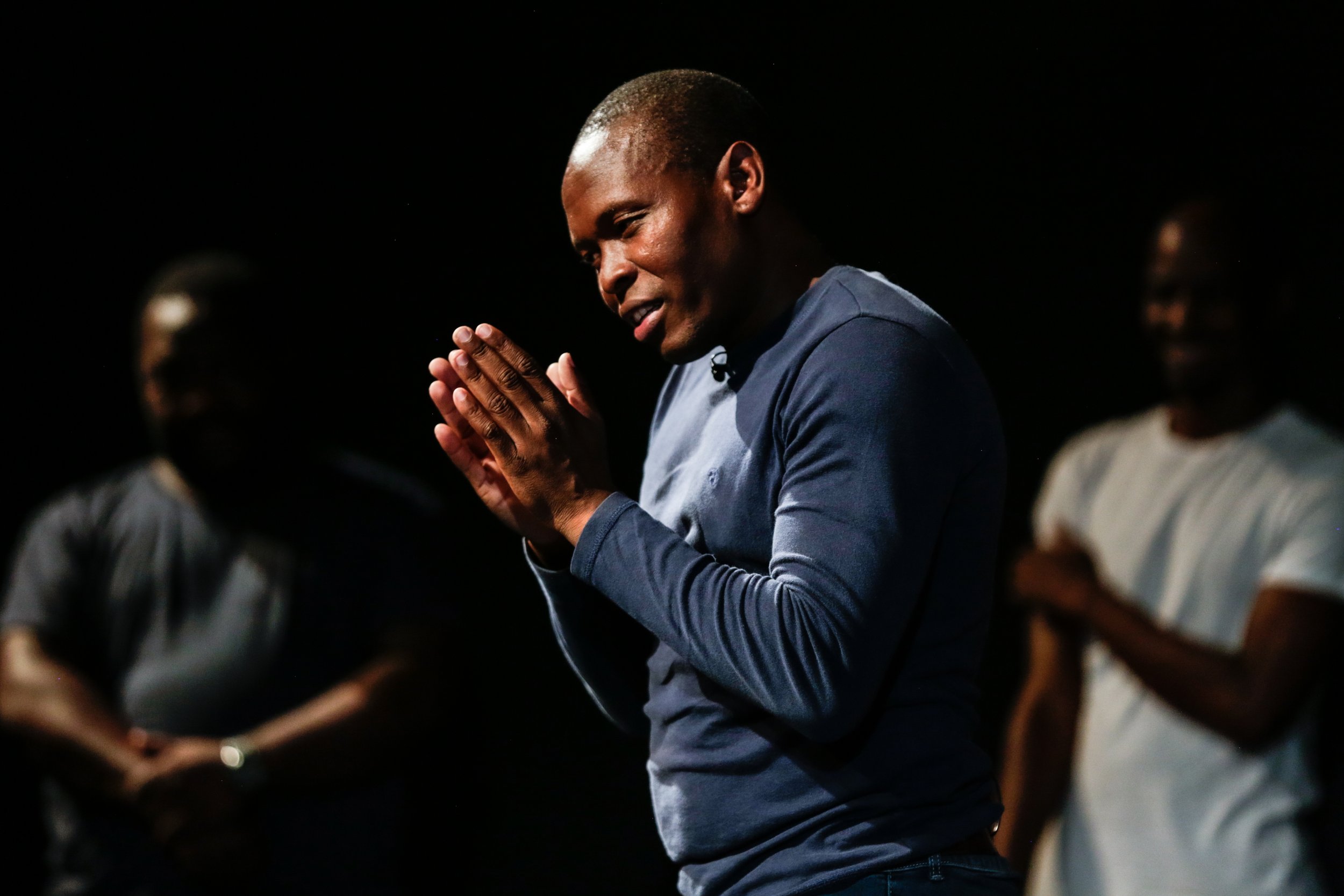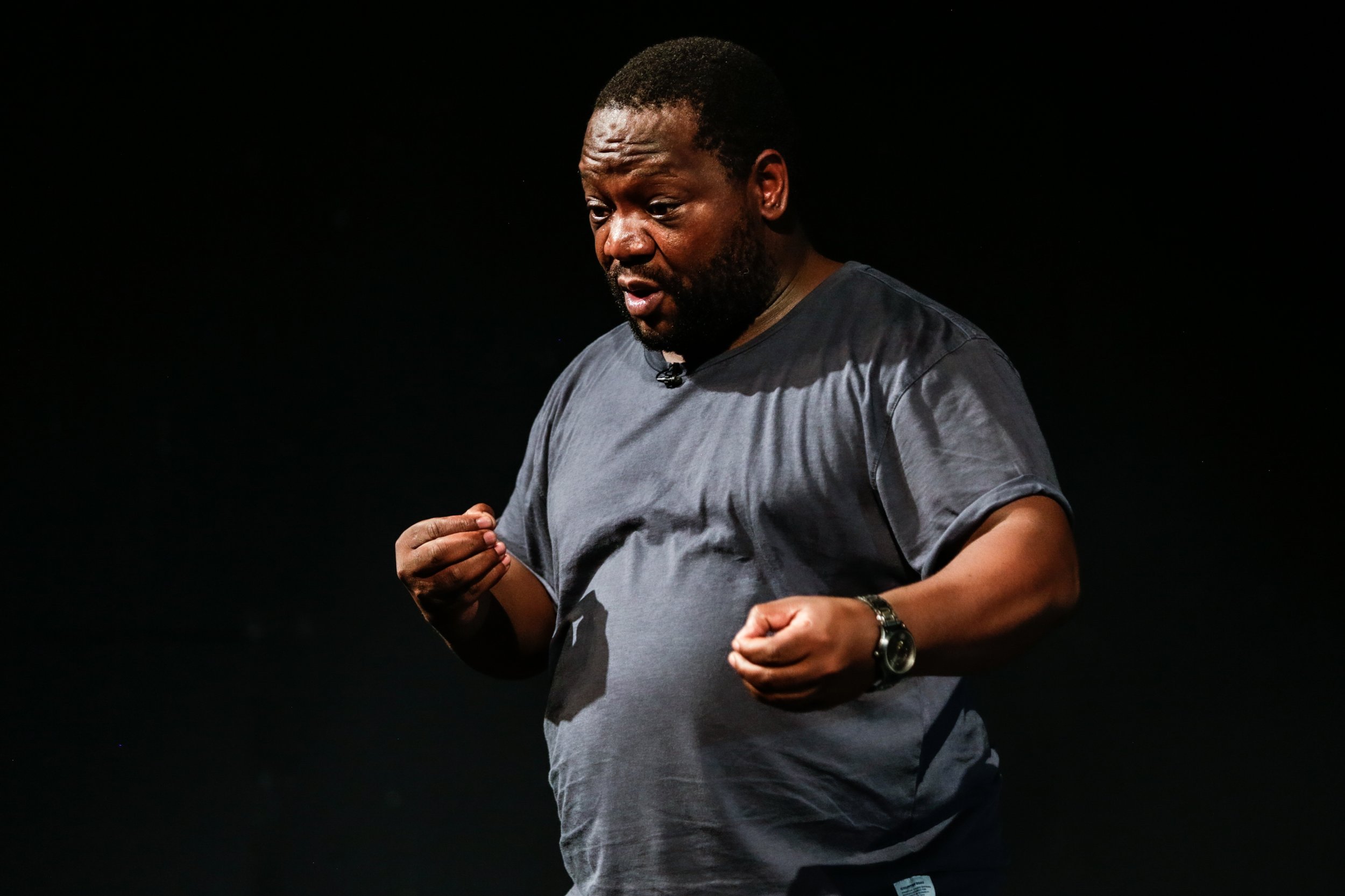They are already in the process of making when the audience enters. To the back of the stage, a row of eight chairs. To the front, a pile of used shoes. A cast of seven musicians and performers, led by their director and their composer, are in a huddle at the centre of the stage, developing a harmonious vocal melody. So begins HOW | Showing the Making: African Exodus.
For the first HOW | Showing the Making of 2023, SO | The Academy for the Less Good Idea invites Sbusiso Shozi and Nhlanhla Mahlangu to give insight into the creation of African Exodus, ahead of its tour to Komische Oper for the Schall&Rausch – Festival für brandneues Musiktheater.
In this HOW, Shozi (writer, composer and musical director) and Mahlangu (director), are joined by the cast of seven singers, musicians and performers, and present extracts from the work, discussing and demonstrating the compositional and theatre-making processes that led to its creation.
The origins of African Exodus
African Exodus is a musical odyssey about the history of African migration, where the music of the continent becomes a tool for retracing, or perhaps redrawing, the footsteps of the Bantu people that have long since been lost to history.
For their HOW, Shozi (writer, composer and musical director) and Mahlangu (director) provided insights into the origins of African Exodus across several levels.
A chance meeting through a corporate gig saw Mahlangu and Shozi cross paths. Both artists were hired as composers for a team-building exercise and tasked with using, among other songs, Rihanna’s hit single ‘Diamonds’ as the musical foundation. “It’s become a song that reminds us, every time we hear it, of how we first met,” explains Mahlangu.
A short karaoke exercise with the audience, using ‘Diamonds’ once again, becomes a way of activating performers and audience members alike. Following this, a deconstructed version of the song composed in real-time helps to demonstrate some of the ways in which Shozi and Mahlangu have worked with the cast to compose the sounds of African Exodus. “It’s about finding it on the spot,” explains Shozi, “It’s about going through the process together.”
The thematic points of origin for African Exodus are also discussed. Here, Shozi explains how instances of xenophobic violence in South Africa gave way to the initial impulse behind the performance. “We need a deeper understanding of ourselves. Africa belongs to everyone who lives in it,” says Shozi.
Music and migration
Following the thematic impulse of how African citizens have come to move across the continent over the years, Shozi presented the first iteration of African Exodus at The Centre in 2018.
It was here, he explains, that he realised he needed more knowledge on the subject if he was going to develop the work further. He pursued a degree in Musicology through the University of South Africa and learned more about the history and deep complexity of music across Africa.
In February 2021, Shozi returned to The Centre to stage Uhambo, Imizwa Nomsindo!, a further exploration of music, migration and, subsequently, language.
“I realised there was still something missing. I began an archaeological linguistic approach… I started researching different African languages,” explains Shozi.
This combination of language, music and the organic compositions that emerged in the research and rehearsal process, became tools for excavating the lost history of African migration. Importantly, music and performance also became ways of accessing and honouring those who have been lost to history.
As Shozi has previously stated: “If we can’t find the bodies, or exhume the bodies, how do we fetch the spirits? If we don’t know where and when their deaths happened, where do we go to mourn? We compose songs from messages we received as fragments from our dreams and deep thoughts to bring their spirits hither through ingoma – song, vibration, dance and rhythm. We know they have left their footprints in the sand, in the water, in the air and in the ether.”
The body as a site of memory
While Shozi (above, left) was developing compositions through music and language, Mahlangu (above, right) joined the process and introduced a way of excavating memory and history through the body.
“Memory is surfaced through performance. The body has history, the body remembers. It remembers what I have forgotten,” says Mahlangu. “When I arrived at that first rehearsal they had developed a rhythm with clapping, but it was all written out as a set of instructions to follow on the wall. It was a game of numbers and I said ‘no, this is something that has to go in the body’.”
For Mahlangu, another way of locating one’s own body in the material of the performance is to lead with questions. In the case of African Exodus, questions emerged around one’s personal migration, what this looks like, the feeling it evokes, and where this is located or felt in the body.
Merging Mahlangu and Shozi’s approaches gives way to a live demonstration of memory, music and rhythm – one of many striking moments taken directly from the performance.
In a similar demonstration, Mahlangu calls on two members from the audience and asks them to embody migration through a single action. Along with the cast, Mahlangu folds these two gestures into a live, improvisational performance along with Shozi’s musical direction. It is a simple and singular moment that demonstrates, perfectly, the processes and methodologies applied by the two directors in the making of African Exodus.
Worn-out soles
Shared musical, linguistic and migratory histories are the driving forces behind the narrative of African Exodus. It is only the performers, with their voices and their bodies, that occupy the stage. Their props? A pile of worn, interlaced shoes.
More than 80 pairs of shoes are used in African Exodus. Over the course of the performance, they become phones, bowls, make-up applicators, and percussive instruments. They also serve as narrative vessels, and markers of movement and migration. As one audience member remarks in the Q&A session following the HOW, the shoes also come to represent people.
Collectively, explains Shozi, these shoes are a nod to the countless souls who have migrated across the African continent, and to those who continue to migrate in their personal lives – worn-out travellers embarking on the journey of daily life.
As Mahlangu has put it: "African Exodus uses shoes to account for a time lived and the remnants of such a time. Lots of shoes are used to explore paths, ways and roads we have taken in our lives."
– David Mann
CREDITS:
WRITER, COMPOSER, MUSICAL DIRECTOR & PRODUCER | Sbusiso Shozi
DIRECTOR | Nhlanhla Mahlangu
PERFORMERS | Sbusiso Shozi, Thabo Gwadiso, Simphiwe Skhakhane, Thulani Zwane, Dikeledi Modubu, Lindokuhle Thabede & Isaac Kenny Mahlodi Rakotsoane
MUSICIANS | Yogin Sullaphen & Volley Nchabeleng
LIGHTING DESIGNER | Wesley France
SOUND ENGINEER | Zain Vally
STAGE MANAGER | Dimakatso Motholo




